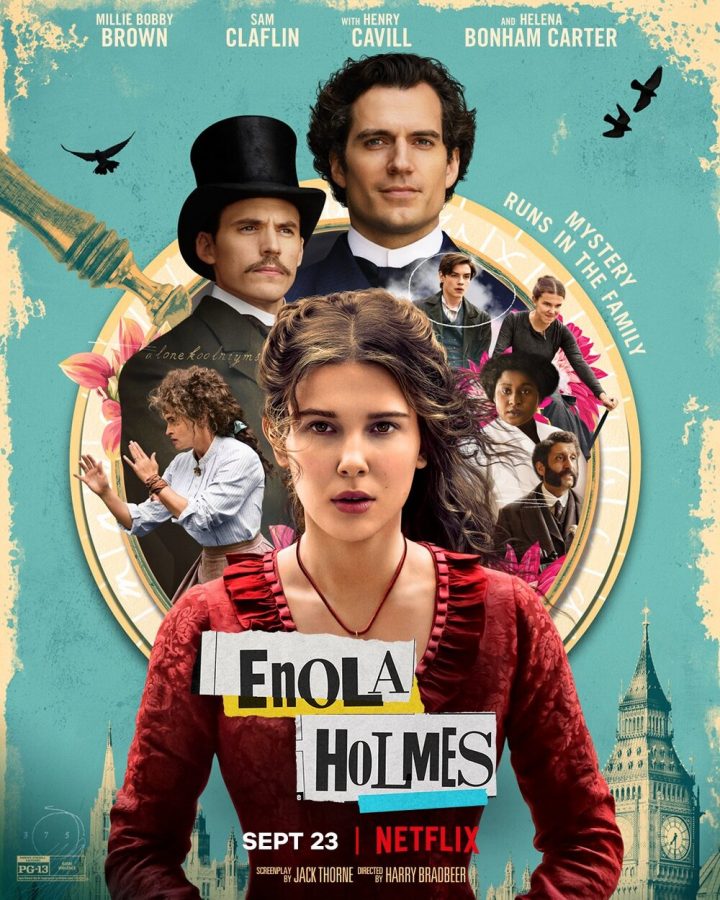Enola Holmes: Why it’s important to have teenagers play teenagers
October 7, 2020
It would be funny to see grown men and women worried about petty high school drama and going through puberty if it weren’t such a common occurrence. By now, everybody is used to seeing fresh-faced 15 year olds in high school being played by 20-somethings with flawless skin and perfect hair.
It’s so rare to see young actors being cast to play young characters, but “Enola Holmes”, a Netflix original based on a book series of the same name, casts Millie Bobby Brown as the 16 year old protagonist and Louis Patridge as our 17 year old Viscount Tewskbury Marquess of Basilwether. The actors were 15 and 16 respectively while filming the movie, and it’s clear that this casting choice was a good one.
A big reason that movies often cast older actors to play younger characters is due to child labour laws and how many hours they will be available to work on set. In cases where stunt work is required, it is easier and less expensive to insure older actors. So, is it worth spending the extra time and money on younger actors?
Absolutely. Not only does this let children see themselves in stories, but it also helps get rid of big age gaps between the actors. One good example is “Another Cinderella Story”, where Selena Gomez, a 16 year old played Mary Santiago, and her male love interest was played by Drew Seeley, who was 26 years old at the time of shooting. Yes, he could pass as 16 or 17, but would it really have been that hard to cast someone younger?
In “Enola Holmes,” Enola is allowed to be a child. Brown looks 15 in the film, she’s allowed to goof around, be a child and (remarkably) isn’t sexualized at all. Enola is playful and lighthearted, and she isn’t too mature for her age. She’s still learning about the world as she goes on, getting into trouble and getting out just as quickly. It feels true to what a 16 year old would behave like in the late 1800s when the film is set.
Enola’s quick glances into the camera, breaking the fourth wall, are a little odd at first, but they become a source of delight as she directly addresses the audience and speaks what they’re thinking. It only helps strengthen the narrative and emphasize that she is telling the story- it’s letting us know that she has control over her own life, which is very empowering.
Not to mention the childish and well-developed relationship between her and the Viscount Tewksbury, who never once overshadowed Enola. Instead, he becomes a steadfast friend and helps her achieve her goals. Their relationship isn’t rushed, and while it’s clear they are heading towards a romantic ending, they are teenagers with bigger things to worry about; They are still finding their place in a world that’s about to change completely.
The movie touches on searching for independence and learning how to separate oneself from what society expects. Those themes make it deeply relatable to children and teenagers trying to find themselves. The movie does a brilliant job letting children be children and letting them grow at their own pace. The casting makes Enola seem even more impressive with how clever and resourceful she is. Unlike many period pieces, her clothes don’t exist to make her seem more ‘sexy’, they serve as practical costumes and disguises.
Yes, she looks way younger than we’re used to and almost too childish occasionally, but that’s what happens when all the ‘teenagers’ on screen also moonlight as strippers at night. Looking at you, Riverdale. When 19 year old Tom Holland was cast to play 15 year old Peter Parker, there was some discourse stating he looked too young to play a freshman. Of course he looked too young; The last two Peter Parkers, while played by amazing actors, were in their twenties when they played Spiderman.
If we continue to let casting directors cast adults as teenagers, we take away the chance for children to really connect with characters on screen. When adults are playing kids on television, you’re not letting children star in their own stories. We need to appreciate kids being kids on camera, with all their lightheartedness, so that they are not aged up unrealistically for the sake of drama. Ultimately, we need to let children be children.



Mr. Walz • Oct 22, 2020 at 10:15 pm
Ms. Sharma, I am old enough to remember the original 90210 TV show, and your piece brought back a rush of memories. I remember being in middle school seeing these 20 somethings (I think one actress was in her 30s) playing high schoolers. Only to be pretty disappointed that I never looked that mature in high school. I agree with you, there is a certain authenticity that comes from casting actors of the appropriate age.